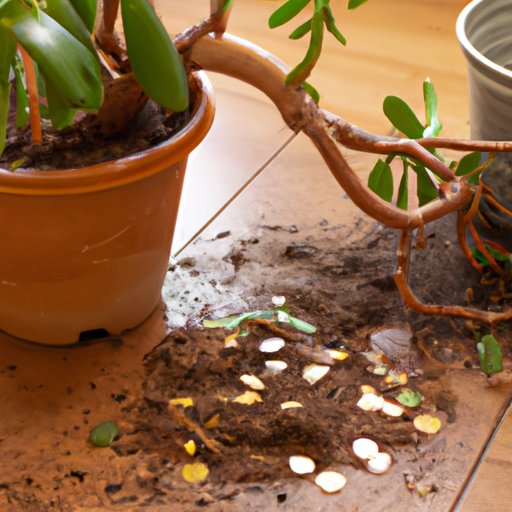
Introduction
If you have a money tree, you may notice that over time, it outgrows its pot and needs to be repotted. Repotting a money tree can help to prevent issues like root rot and promote healthier growth. In this article, we will provide a step-by-step guide to help you repot your money tree successfully.
Step-by-Step Guide
The following steps will help you repot your money tree:
Choosing the Right Sized Pot
Choose a pot that is one size larger than the current pot your money tree is in to give it room to grow. A larger pot will allow the roots to have more space and prevent the plant from becoming root-bound.
Preparing the New Pot
Clean the new pot with mild soap and water and ensure that it has drainage holes to prevent water from sitting in the soil. You can cover the holes with mesh or broken pot pieces to keep the soil from falling out.
Removing the Money Tree from the Old Pot
To remove the plant from the old pot, gently turn it upside down while supporting the stem. Tap the bottom of the pot or use a trowel to loosen the soil and roots. Once the plant is loose, you can now lift it out with ease.
Preparing the Money Tree for Repotting
Remove any dead or damaged leaves or branches from the money tree. Use a pair of scissors or pruning shears to prune any overgrown roots.
Repotting the Money Tree
Add enough soil to the new pot to ensure the tree will be at the same level as before. Place the money tree in the new pot and add soil gently around the root ball, making sure it is firmly in place. Tamp the soil down lightly around the tree.
Watering the Plant
Water the plant thoroughly, making sure that the soil is moist but not over-saturated. Add additional soil if necessary, as it will settle after a few days.
Choosing the Right Soil
Choosing the right soil for your money tree is essential, as it can help promote growth and prevent root rot. A well-draining soil mix is necessary to prevent overwatering and lead to root rot. You can use cactus mix or a pre-mixed soil specifically formulated for indoor plants. Both soil options contain sand or perlite, which helps with water drainage, preventing the soil from retaining water and becoming waterlogged.
Signs Your Money Tree Needs Repotting
It is essential to check the roots of your money tree regularly to ensure it is healthy and not root-bound. Here are some signs that your money tree needs repotting:
Wilting Leaves
If your money tree leaves are wilting or yellowing and the soil remains damp, it is a sign that the plant may not be receiving enough oxygen due to the root holding on to too much water.
Waterlogged Soil
Waterlogged soil is a sign that the current pot is too small, preventing the roots from growing freely.
Emerging Roots from the Drainage Holes
If you notice some roots coming out from the drainage holes, it means that your plant has outgrown its pot, and it is time to repot.
Common Mistakes to Avoid
Here are some common mistakes to avoid when repotting your money tree:
Over-packing the Soil
Over-packing the soil can prevent water from draining and lead to root rot.
Choosing the Wrong Pot Size
Choosing a pot that is too small can limit growth and root development, while choosing a pot that is too large can lead to over-watering and root rot.
Not Checking the Roots
Not checking the roots before repotting can lead to root damage and stunt plant growth.
Not Watering Enough
Watering your newly repotted plant is essential to provide moisture and settle the soil. Ensure that you do not over-water or under-water the plant.
Tools Needed for Repotting
Here are some tools you will need for repotting your money tree:
Pot
A new pot one size larger than the current pot.
Soil
Well-draining soil to promote healthy root development.
Trowel
A trowel to help loosen the plant from the current pot and to add soil to the new pot.
Gardening Gloves
Gardening gloves to protect your hands from sharp edges and prickly leaves.
Watering Can
A watering can to moisten the soil and ensure adequate moisture to the plant.
Scissors
Scissors or pruning shears to remove dead or damaged leaves and prune overgrown roots.
Best Time to Repot
The best time to repot your money tree is in the early spring or late winter before the growing season begins. Avoid repotting during the summer months as this can be stressful for the plant and lead to issues such as root rot.
Conclusion
Repotting your money tree can help to boost growth and prevent root rot. Choose the right size pot and soil mix, check for signs that your money tree needs repotting and avoid common mistakes to ensure a successful repotting experience. With the right tools and care, you can quickly repot your money tree and enjoy its healthy growth.





